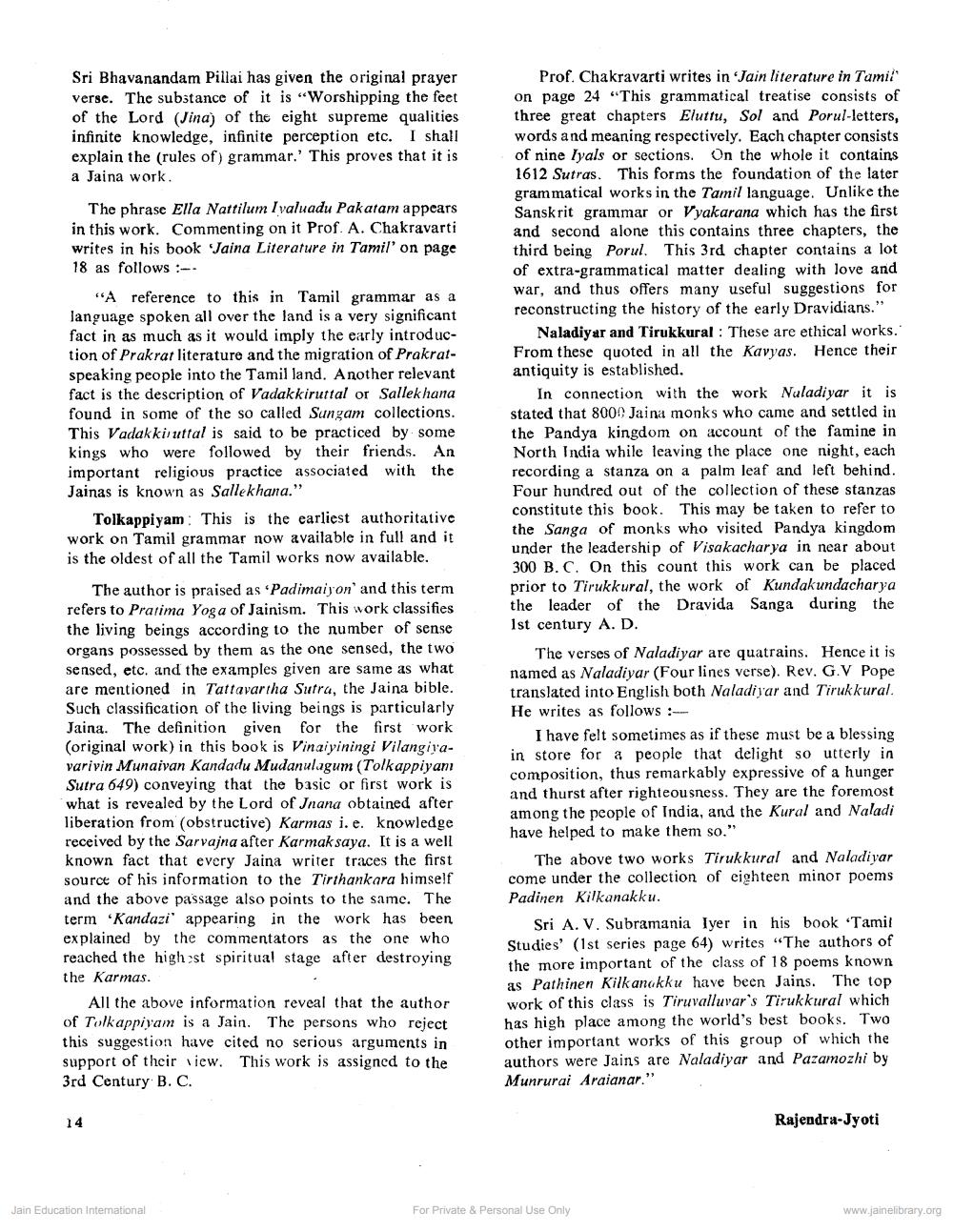Book Title: Jainism in Tamilnadu Author(s): S Gajpathi Publisher: Z_Rajendrasuri_Janma_Sardh_Shatabdi_Granth_012039.pdf View full book textPage 3
________________ Sri Bhavanandam Pillai has given the original prayer verse. The substance of it is Worshipping the feet of the Lord (Jina) of the eight supreme qualities infinite knowledge, infinite perception etc. I shall explain the (rules of) grammar.' This proves that it is a Jaina work. The phrase Ella Nattilum I valuadu Pakatam appears in this work. Commenting on it Prof. A. Chakravarti writes in his book Taina Literature in Tamil' on page 18 as follows: "A reference to this in Tamil grammar as a language spoken all over the land is a very significant fact in as much as it would imply the early introduction of Prakrat literature and the migration of Prakratspeaking people into the Tamil land. Another relevant fact is the description of Vadakkiruttal or Sallek hana found in some of the so called Sungam collections. This Vadakki, uttal is said to be practiced by some kings who were followed by their friends. An important religious practice associated with the Jainas is known as Sallekhana." Tolkappiyam: This is the earliest authoritative work on Tamil grammar now available in full and it is the oldest of all the Tamil works now available. The author is praised as "Padimaiyon' and this term refers to Pratima Yoga of Jainism. This work classifies the living beings according to the number of sense organs possessed by them as the one sensed, the two sensed, etc. and the examples given are same as what are mentioned in Tattavartha Sutra, the Jaina bible. Such classification of the living beings is particularly Jaina. The definition given for the first work (original work) in this book is Vinaiyiningi Vilangiravarivin Munaivan Kandadu Mudanulagum (Tolkappiyam Sutra 649) conveying that the basic or first work is what is revealed by the Lord of Jnana obtained after liberation from (obstructive) Karmas i.e. knowledge received by the Sarvajna after Karmak saya. It is a well known fact that every Jaina writer traces the first source of his information to the Tirthankara himself and the above passage also points to the same. The term 'Kandazi' appearing in the work has been explained by the commentators as the one who reached the highst spiritual stage after destroying the Karmas. All the above information reveal that the author of Tolkappiyam is a Jain. The persons who reject this suggestion have cited no serious arguments in support of their view. This work is assigned to the 3rd Century B. C. Prof. Chakravarti writes in Jain literature in Tamil on page 24 "This grammatical treatise consists of three great chapters Eluttu, Sol and Porul-letters, words and meaning respectively. Each chapter consists of nine Iyals or sections. On the whole it contains 1612 Sutras. This forms the foundation of the later grammatical works in the Tamil language. Unlike the Sanskrit grammar or Vyakarana which has the first and second alone this contains three chapters, the third being Porul. This 3rd chapter contains a lot of extra-grammatical matter dealing with love and war, and thus offers many useful suggestions for reconstructing the history of the early Dravidians." Naladiyar and Tirukkural: These are ethical works. From these quoted in all the Kavyas. Hence their antiquity is established. In connection with the work Nuladi yar it is stated that 800 Jaina monks who came and settled in the Pandya kingdom on account of the famine in North India while leaving the place one night, each recording a stanza on a palm leaf and left behind. Four hundred out of the collection of these stanzas constitute this book. This may be taken to refer to the Sanga of monks who visited Pandya kingdom under the leadership of Visakacharya in near about 300 B.C. On this count this work can be placed prior to Tirukkural, the work of Kundak undacharya the leader of the Dravida Sanga during the 1st century A. D. The verses of Naladiyar are quatrains. Hence it is named as Naladiyar (Four lines verse). Rev. G.V Pope translated into English both Naladiyar and Tirukkural. He writes as follows: I have felt sometimes as if these must be a blessing in store for a people that delight soutterly in composition, thus remarkably expressive of a hunger and thurst after righteousness. They are the foremost among the people of India, and the Kural and Naladi have helped to make them so." The above two works Tirukkural and Naladi var come under the collection of eighteen minor poems Padinen Kilkanakku. Sri A. V. Subramania Iyer in his book "Tamil Studies' (1st series page 64) writes "The authors of the more important of the class of 18 poems known as Pathinen Kilkanakku have been Jains. The top work of this class is Tiruvalluvar's Tirukkural which has high place among the world's best books. Two other important works of this group of which the authors were Jains are Naladiyar and Pazamozhi by Munrurai Araianar." 14 Rajendra-Jyoti Jain Education Intemational For Private & Personal Use Only www.jainelibrary.orgPage Navigation
1 2 3 4 5 6 7 8 9 10 11 12
